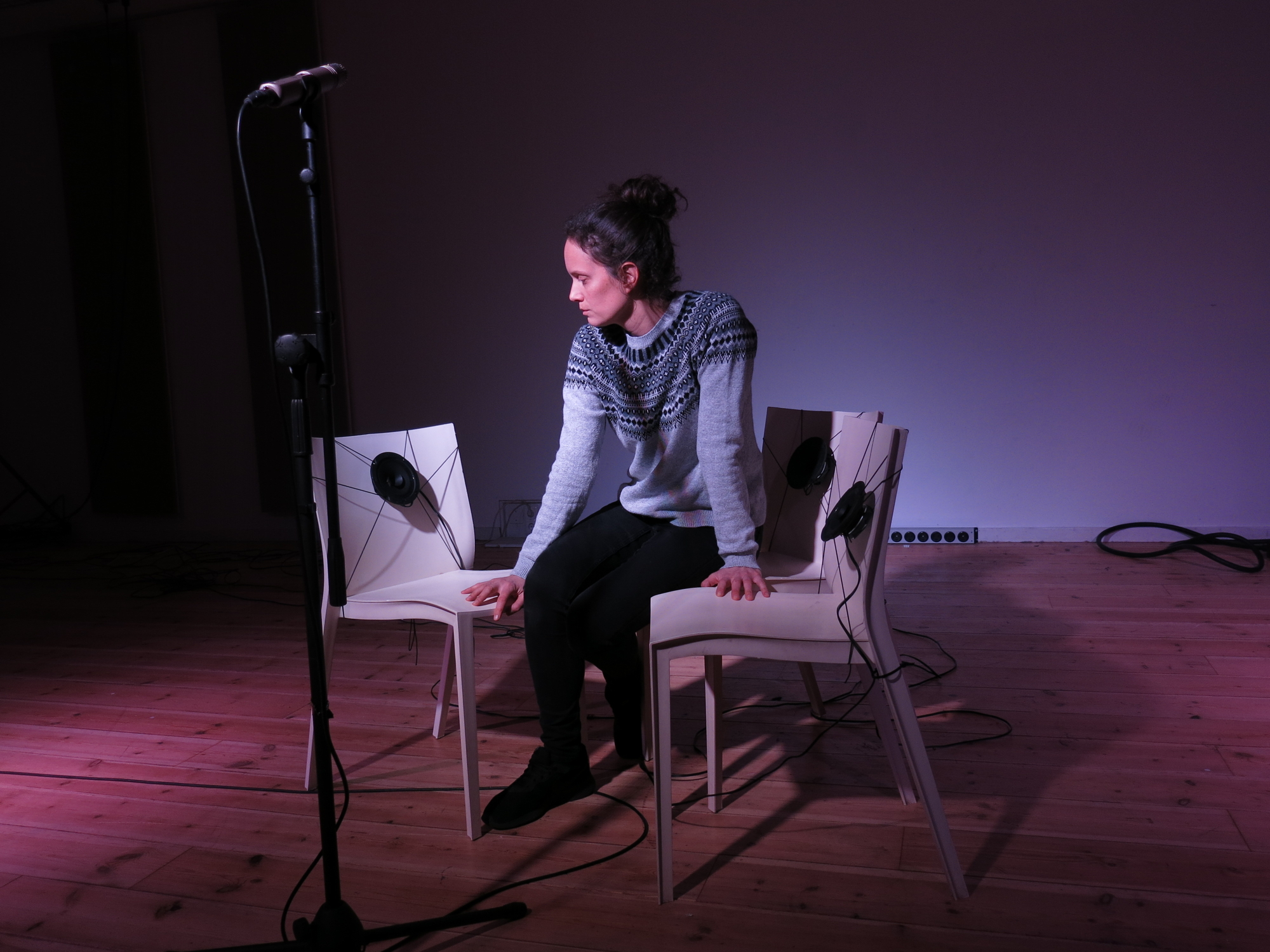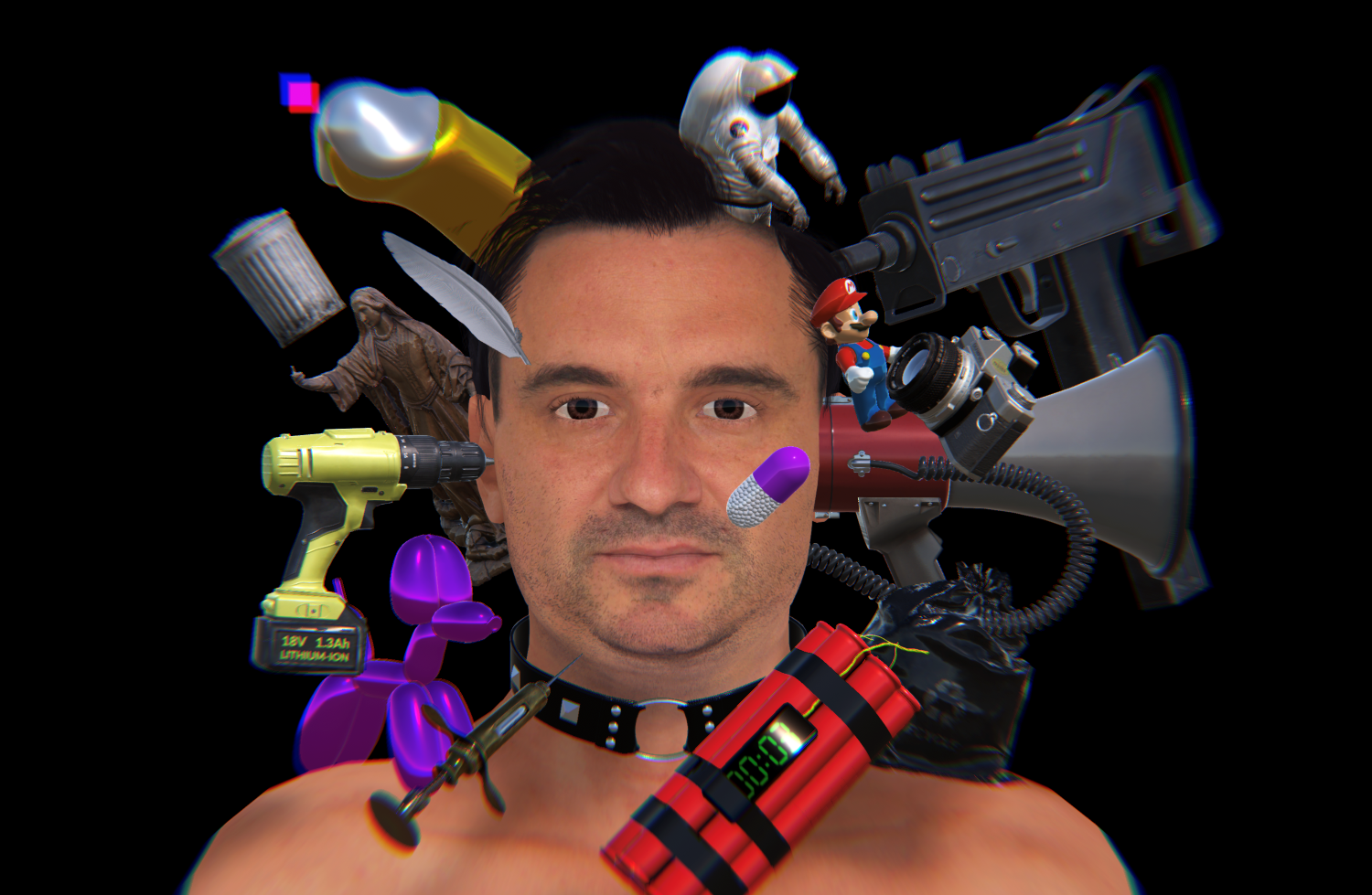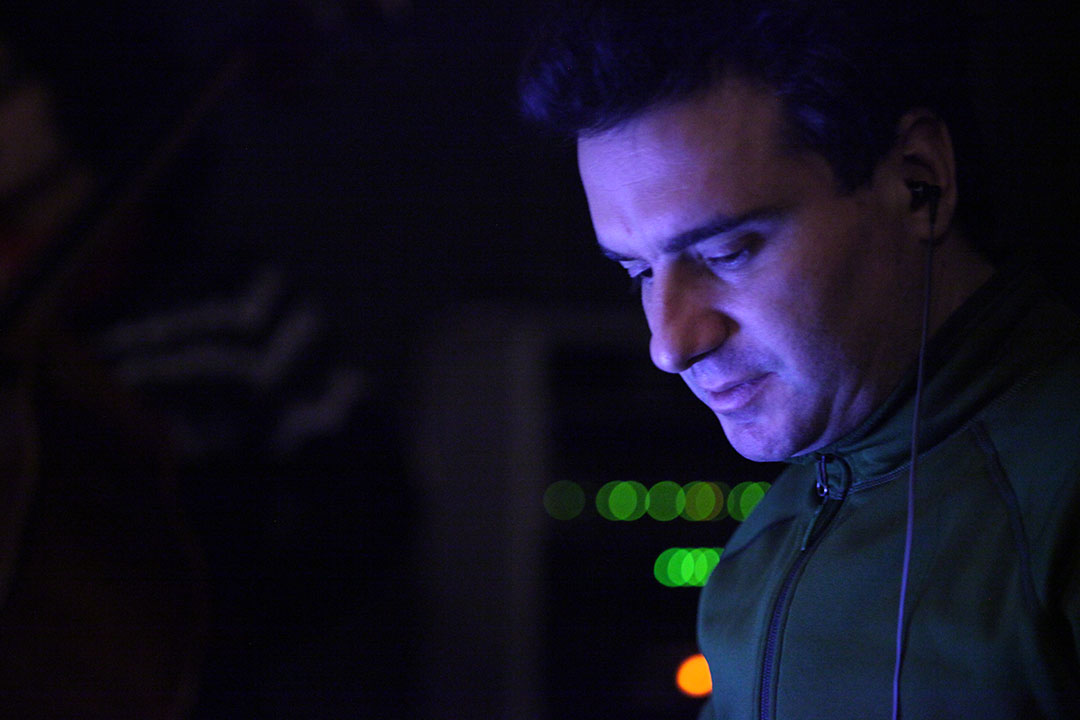Désolé, cet article est seulement disponible en allemand et anglais américain.
Cathy Van Eck : le caractère transcendant d’une pièce de concert
Cathy Van Eck, compositrice et artiste multimédia, marque la scène musicale contemporaine suisse et internationale par ses performances sonores subtiles et très esthétiques. Sa pièce In the Woods of Golden Resonances pour batterie solo a occupé une place particulière au sein d’une soirée musicale consacrée à la batterie. Un portrait d’Alexandre Babel.
Alexandre Babel
Le slogan sonne comme une invitation : sous le titre Aufbau/Abbau (montage/démontage), le percussionniste espagnol Miguel Angel Garcia Martin a organisé une soirée de concert entièrement consacrée à la batterie solo dans la série friendly takeover de la Gare du Nord à Bâle. Six créations visaient à mettre en lumière la réalité logistique du percussionniste professionnel. En effet, le montage et le démontage de ces instruments pour un concert prennent en général presque autant de place et d’importance que le moment musical lui-même. Même si le thème de la soirée peut paraître a priori anecdotique, il était en l’occurrence à la base d’un questionnement aux nombreuses ramifications, que tous les contributeurs invités se sont appropriés en créant une nouvelle œuvre. In the Woods of Golden Resonances de Cathy Van Eck en est un exemple révélateur.

In the Woods of Golden Resonances montre le batteur Miguel Angel Garcia Martin au centre de la scène, dans une relative pénombre, avec une lampe frontale rouge, de sorte que le public ne distingue que sa silhouette. Avec des mouvements lents et contrôlés, il se dirige vers une cymbale posée sur le sol dans un coin de la scène, la soulève puis la tient à hauteur de bouche en position horizontale. Un son de respiration distinct et amplifié indique que le performeur porte un microphone et souffle sur l’instrument, comme s’il essayait d’en enlever la poussière. Ce son est manifestement traité électroniquement, et sa restitution par les haut-parleurs constitue la majeure partie de l’environnement sonore. « En soufflant, le ‘volume’ des deux haut-parleurs dans la pièce augmente et un son de feedback acoustique est créé. Toute la pièce est constituée de ces feedbacks, comme si Miguel ‘respirait’ la pièce », explique Cathy van Eck.
Il se dirige ensuite vers un support métallique sur lequel il pose son instrument. Cette action simple, mais soigneusement chorégraphiée, est répétée plusieurs fois avec d’autres cymbales cachées dans la pièce. Il permet au public d’observer la construction progressive et ritualisée d’une installation de percussions sur scène.
Dans les œuvres de Cathy van Eck, le corps du musicien est souvent au centre. La Néerlandaise est titulaire d’un doctorat de l’Université de Leyde. Elle publie et fait de la recherche, entre autres, sur les liens possibles entre gestes, capteurs et sons, et enseigne au Sound Arts Department de la Haute école des arts de Berne. «Dans In the Woods of Golden Resonances aussi, une forte relation entre les mouvements du performeur et son matériel est établie. Ses mouvements ne sont pas conçus comme un ‘montrer vers l’extérieur’, avec comme but de ‘contrôler le son’, mais plutôt comme une recherche et une perception prudentes. C’est pourquoi, dans cette pièce, Miguel a une attitude différente sur scène par rapport aux autres pièces de la soirée », explique van Eck.
Cathy van Eck, In the Woods of Golden Resonances, Miguel Angel Garcia Martin, création mondiale Gare du Nord Basel, 9.4.2024.
La force de In the Woods of Golden Resonances réside dans son placement formel répétitif et simple. La pièce sert à passer d’un état A à un état B et se termine une fois l’installation terminée. La partition de Cathy Van Eck ne prévoyant pas de jouer sur les cymbales une fois installées. Au lieu de cela, elles servent de structure pour une autre pièce du programme, Cymbals de Barblina Meierhans. La pièce de Van Eck ne traduit donc pas seulement exactement le thème du concert, mais tisse aussi un lien concret avec l’élément suivant de la soirée.
Le moment de l’installation, la transformation de la scène, constituent entièrement la pièce, alors que l’on cherche habituellement à réduire la durée et l’importance de la transformation pour assurer la fluidité musicale, In the Woods of Golden Resonances fait exactement le contraire. L’oeuvre utilise cet espace entre deux états pour un moment d’introspection dans l’intimité du musicien. Les choix esthétiques de Van Eck, comme l’atmosphère rêveuse créée par la pénombre ou l’impression sensuelle laissée par l’amplification des bruits de respiration du musicien, soulignent cette introspection.
L’effet de l’œuvre est d’évoquer de manière poétique la réalité technique du batteur avec son instrumentation, tout en la reliant à la réalité de son environnement. La dimension spatiale de la salle de concert est également soulignée. Cathy van Eck explique à ce sujet : «Les sons naissent d’une interaction entre la position exacte dans l’espace de Miguel, des cymbales, des haut-parleurs et bien sûr aussi l’acoustique de la salle».
Mais Van Eck va encore plus loin en invitant le public à se considérer partie prenante du processus. Des effets sonores comme le traitement électronique à haut volume créent une impression d’immersion et le ‘ballet’ proprement dit du batteur donne au public l’illusion de faire partie du processus. Enfin, grâce à l’effet de lumière, elle ‘neutralise’ la figure du batteur en simple silhouette à laquelle chacun peut s’identifier. Van Eck explique à ce sujet : «Dans ce cas, la lumière était une décision du batteur Miguel, qui a travaillé avec moi et le metteur en scène. Je peux très bien imaginer cette pièce dans un environnement plus lumineux. Pour moi, la façon dont la lumière est conçue dépend beaucoup de la salle».
In the Woods of Golden Resonances fait partie d’une série d’œuvres successives et différenciées. Cette composition subvertit les attentes habituelles d’une pièce de concert tout en respectant son code primaire, car le traitement du son est si intéressant qu’il peut tout aussi bien être ‘écouté’.
Mais le rôle de l’œuvre individuelle ou de son créateur est remis en question au profit d’une unité qui crée un lien entre les éléments. Je me demande si la nécessité de la création ne réside pas dans le fait qu’elle fasse passer d’un état à un autre ?
Alexandre Babel
Alexandre Babel est originaire de Genève et vit à Berlin. Compositeur, percussionniste, curateur et publiciste, ce texte est sa première contribution au blog de neo.
Neo-profiles :
Cathy van Eck, Gare du Nord, Alexandre Babel
Sendungen SRF Kultur:
Musik unserer Zeit, 29.01.2014: Grünes Rauschen – Klangkunst mit Cathy van Eck, auteure/rédactrice Cécile Olshausen.
Onlinetext, 28.01.2014: Bei Cathy van Eck klingt Gewöhnliches ungewöhnlich, auteure Cécile Olshausen.
Musik unserer Zeit, 16.6.2021: Alexandre Babel: Perkussionist, Komponist, Kurator, auteure/rédactrice Gabrielle Weber.
neoblog, 10.09.2021: un projet est avant tout une rencontre.., auteure Gabrielle Weber.
(Deutsch) Sabina Meyer – Scelsi, Barock und eigene Songs
(Deutsch) Klangkunst von „Sonic Architect“ Merlin Modulaw
(Deutsch) Uraufführung in 100 Jahren?
(Deutsch) Komponieren für Streichquartett mit dem Arditti Quartett
(Deutsch) Thomas Kessler – Klangutopist und Elektronikpionier ist verstorben
Daniel Zea compose pour des boîtes en carton et des avatars
Le compositeur colombien-suisse Daniel Zea conçoit le son en tant que matière plastique. Dans ses œuvres, il associe sons, mouvement, électronique et vidéo avec des configurations numériques. Un portrait de Jaronas Scheurer.
Jaronas Scheurer
«Je compose de la musique plus comme le ferait un designer qu’un compositeur», déclare Daniel Zea au cours de notre entretien. «Ce qui m’intéresse sont des sujets comme la symétrie ou l’asymétrie, l’ergonomie et l’équilibre, et je conçois le son comme une matière plastique». Zea a également étudié le design industriel en Colombie, avant d’étudier la composition à Bogotá avec Harold Vasquez-Castañeda, puis de venir à Genève pour terminer ses études avec Eric Gaudibert à la haute école de musique (HEM). Il s’est ensuite formé pendant deux ans à l’Institut de sonologie de la Hague, avant de co-fonder l’ensemble Vortex et d’enseigner design interactif à la HEM de Genève: Le CV de Daniel Zea est donc long et varié – designer industriel, compositeur, designer audio, artiste média, programmeur.

Daniel Zea compose généralement pour des réseaux complexes, où interprètes, instruments traditionnels ainsi que développés par ses soins, électronique, projections vidéo et programmes informatiques sont reliés entre eux. «Lorsque je travaille avec des systèmes interactifs, il s’agit en fait à chaque fois d’un projet de conception: je développe une configuration qui combine le matériel, le logiciel et l’interaction humaine de manière à créer du son, de la musique». Ses œuvres associent mouvement et son en résultant en des instruments développés par ses soins ou en partitions qui se génèrent en temps réel – comme par exemple dans Box Tsunami de 2021.
Daniel Zea a composé Box Tsunami 2021 pendant la pandémie de Corona pour les quatre musiciens du Concept Store Quartet.
Box Tsunami
Zea a écrit Box Tsunami pour le jeune quatuor bâlois Concept Store Quartet pendant la pandémie. L’énormité des colis envoyés, symbole de la frénésie de consommation, a été son point de départ: «Un homme devant une boîte vide – c’est déjà très poétique. Qu’est-ce que cela signifie? Pourquoi l’homme est-il assis là? Pourquoi la boîte est-elle vide?» Et c’est ainsi que Box Tsunami commence: quatre musiciens.ennes sont assis avec leurs instruments et un ordinateur portable devant de grandes boîtes en carton. La partie supérieure de celles-ci est ouverte et une lumière blanche en sort. Des coups, des bruits et des grincements se font entendre dans les boîtes. Les musiciens.ennes sont concentrés sur leurs ordinateurs portables et superposent des sons délicats et filigranes aux bruits qui sortent des boîtes – chacun pour soi, sans trop faire attention aux autres.
Pour Box Tsunami, Zea a commencé par développer les boîtes sonores. Il les a équipé de petits marteaux électriques et de «transducteurs» qui transmettent des signaux comme des sortes de haut-parleurs. La boîte en carton devient ainsi un instrument qu’il commande électroniquement. Les signaux sont toutefois plutôt faibles, c’est pourquoi les quatre musiciens.ennes ne peuvent jouer que doucement et délicatement. Pour relier les musiciens et les boîtes au niveau de la composition, les marteaux électriques sont commandés par le/la percussionniste au moyen d’un drum pad Midi. Une boucle interactive relie les musiciens.ennes et les boîtes en carton et la partition est générée en temps réel. Comme lors des lockdowns, tout le monde est assis devant leur écran, captivé, dépendant des actions des autres et surtout des moyens de communication technologiques, mais ne se rencontrant jamais. Et autour s’empilent les boîtes en carton issues des achats en ligne – Box Tsunami.
In Dans l’autoportrait de Daniel Zea et le solo show Autorretrato de 2023, on le voit assis devant une caméra et, sur l’écran, un avatar de lui plus grand que nature.
Autorretrato
Le cadre de la composition Autorretrato (autoportrait) est plus simple: Zea est lui-même assis devant une caméra pendant que sur l’écran derrière lui, on voit un avatar qui exécute ses mêmes mouvements faciaux, un doublon numérique. Avec les mouvements du visage, Zea peut diriger et manipuler des sons. Au fil du temps, l’écran se peuple de différents objets comme une canette de Coca, des talons hauts, une grenade ou un crucifix. Cela se fait au moyen d’une application de facetracking reliée au programme audio. Pour Autorretrato, Zea est à la fois compositeur, concepteur audio, développeur de logiciels et interprète. «Le plus difficile a certainement été la performance», déclare Zea. «Je n’ai pas l’habitude d’être seul au milieu de la scène et j’étais par conséquent nerveux avant la première. C’est aussi une pièce très personnelle. D’un côté, c’est risqué, mais cela me permet aussi de dire et de faire des choses que je ne ferais pas autrement».
Autorretrato a été conçue récemment et Zea qualifie l’œuvre de «work in progress» : «J’aimerais encore peaufiner et développer certaines parties du morceau. Chaque jour, d’une manière ou d’une autre, nous continuons à travailler sur notre autoportrait », il explique. Zea aussi continue ainsi à construire: il associe le son et le mouvement, étudie en composition les mouvements les plus subtils du visage, développe des instruments et intègre tout cela dans ses réflexions sociopolitiques.
Jaronas Scheurer

Du 30 avril au 5 mai 2024, le Festival les Amplitudes à La Chaux-de-Fonds sera consacré à l’œuvre de Daniel Zea. Entre autres, l’Ensemble Vortex, qu’il a cofondé, jouera ses compositions, une nouvelle œuvre pour orchestre sera présentée et une installation sonore de Daniel Zea et Alexandre Joly aura lieu pendant toute la durée du festival.
Nejc Grm, Alicja Pilarczyk, Pablo González Balaguer
Émissions SRF Kultur:
neoblog, 14.10.2020: la ville – une composition géante, auteur Anya Leveillé
neoblog, 23.01.2022 : Portrait unserer Zeit, Autorin Gabrielle Weber
Neo-Profils: Daniel Zea, Concept Store Quartet, Ensemble Vortex, Eric Gaudibert, Jeanne Larrouturou

